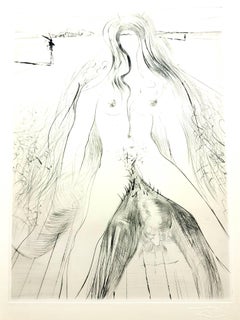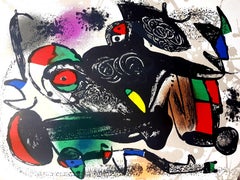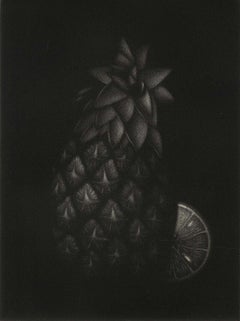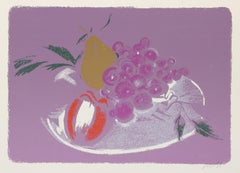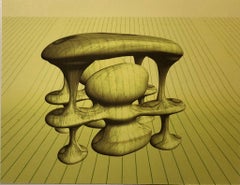Miniature Still-life Prints
to
539
1,777
784
1,053
529
320
Overall Width
to
Overall Height
to
453
361
120
104
34
34
31
28
21
19
15
8
5
3
32
31
30
29
28
111
192
1,007
466
11
6
30
16
73
165
182
127
161
87
101
1,224
357
187
338
252
220
212
183
151
109
89
89
67
66
62
61
56
51
50
46
44
40
38
695
328
306
241
100
126
266
1,059
461
Size: Miniature
HOPE, 2021 (The promise of the new year appears to be floating
By Matt Magee
Located in New Orleans, LA
Hope is an archival color print with sculptured and hot gloss stamp printed in an edition of 50. This is impression #25 of 50.
ARTIST STATEMENT: Language is liquid and as HOPE was ...
Category
2010s Pop Art Still-life Prints
Materials
Archival Ink, Color, Archival Pigment
$225 Sale Price
30% Off
Salvador Dali - Woman on Horse - Original Stamp-Signed Etching
Located in Collonge Bellerive, Geneve, CH
Salvador Dali - Woman on Horse - Original Stamp-Signed Etching
Stamp signed by Dali
Edition of 294 copies.
Paper : Arches vellum.
Dimensions : 16x12"....
Category
1960s Surrealist Figurative Prints
Materials
Etching
Joan Miro - Original Abstract Lithograph
By Joan Miró
Located in Collonge Bellerive, Geneve, CH
Joan Miro Miro Original Abstract Lithograph
Artist: Joan Miro
Medium: Original lithograph on Rives vellum
Portfolio: Miro Lithographe IV
Year: 1981
Editi...
Category
1970s Abstract Abstract Prints
Materials
Lithograph
L' Ananas (The Pineapple, a symbol of hospitality)
Located in New Orleans, LA
Laurent Schkolnyk created this original mezzotint, L' Anais that is signed, titled and numbered #22 in an edition of 30. Since the fruit was so perishable, it became a symbol of lu...
Category
1980s American Modern Landscape Prints
Materials
Mezzotint
Stilleben mit Obstschale, Modern Screenprint after Max Oppenheimer
Located in Long Island City, NY
Max Oppenheimer, After, Austrian (1885 - 1954) - Stilleben mit Obstschale, Year: circa 1925, Medium: Screenprint, Edition: Test Print, Image Size: 8 x 11.25 inches, Size: 12.75 ...
Category
1920s Modern Still-life Prints
Materials
Screen
Digital Iris Print "Schizmo Genesis" Pencil Signed with Initials edition of 15
By Charles Long
Located in Surfside, FL
This is for the one print listed here.
Internalized Page Project. color Iris digital prints on paper, each initialed on verso and numbered from edition of 15. printed & published by ...
Category
1990s Surrealist Abstract Prints
Materials
Digital
Digital Iris Print "Character Exhibition" Pencil Signed w Initials edition of 15
By Charles Long
Located in Surfside, FL
This is for the one print listed here.
Internalized Page Project Vol II. color Iris digital prints on paper, each initialed on verso and numbered from edition of 15. printed & publis...
Category
1990s Surrealist Abstract Prints
Materials
Digital
Tuscan Bunch, 1987 - Still Life Print of Flowers in a Vase, Neutral with Red
By André Bicât
Located in Kingsclere, GB
Born in Essex to French and Anglo-Irish parents, André Bicât was a painter, printmaker and influential teacher.
From 1966-74 he worked as a tutor in the Printmaking Departments at...
Category
20th Century Still-life Prints
Materials
Lithograph
V Intro. 1982. Paper, linocut, 25x31 cm
Located in Riga, LV
V Intro. 1982. Paper, linocut, 25x31 cm
imprint size 20x20 cm total page size 25x31cm
Dainis Rozkalns (1928 - 2018)
Artist, graphic artist, illustrator of folklore and fiction publ...
Category
1980s Folk Art Still-life Prints
Materials
Paper, Linocut
$186 Sale Price
20% Off
Vase aux orchidées
Located in Dallas, TX
This is a three-plate color mezzotint.
The mat dimensions are 20 x 16 inches.
Signed "Schkolnyk" at lower right.
Category
Late 20th Century Art Deco Prints and Multiples
Materials
Mezzotint
Digital Iris Print "Spontaneous Restructuring" Pencil Signed w. Initials ed. 15
By Charles Long
Located in Surfside, FL
This is for the one print listed here.
Internalized Page Project. color Iris digital prints on paper, each initialed on verso and numbered from edition of 15. printed & published by ...
Category
1990s Surrealist Abstract Prints
Materials
Digital
Grapes
Located in New York, NY
A superb, richly-inked impression of this early, very scarce lithograph. Signed and dated in pencil, lower right.
Category
1920s American Modern Still-life Prints
Materials
Lithograph
Digital Iris Print "Effective Disbelief" Pencil Signed w Initials edition of 15
By Charles Long
Located in Surfside, FL
This is for the one print listed here.
Internalized Page Project Vol II. color Iris digital prints on paper, each initialed on verso and numbered from edition of 15. printed & publis...
Category
1990s Surrealist Abstract Prints
Materials
Digital
Digital Iris Print "An Ideadic Camera" Pencil Signed with Initials edition of 15
By Charles Long
Located in Surfside, FL
This is for the one print listed here.
Internalized Page Project Vol II. color Iris digital prints on paper, each initialed on verso and numbered from edition of 15. printed & publis...
Category
1990s Surrealist Abstract Prints
Materials
Digital
Digital Iris Print "Good Internal Object" Pencil Signed w Initials edition of 15
By Charles Long
Located in Surfside, FL
This is for the one print listed here.
Internalized Page Project Vol II. color Iris digital prints on paper, each initialed on verso and numbered from edition of 15. printed & publis...
Category
1990s Surrealist Abstract Prints
Materials
Digital
Digital Iris Photo Print "Fangled No-Being" Pencil Signed w Initials edition 15
By Charles Long
Located in Surfside, FL
This is for the one print listed here.
Internalized Page Project Vol II. color Iris digital prints on paper, each initialed on verso and numbered from edition of 15. printed & publis...
Category
1990s Surrealist Abstract Prints
Materials
Digital
Still Life with Snippers
Located in Buffalo, NY
Richard Huntington (b. 1936) is an american painter, printmaker, and writer, is Critic Emeritus at The Buffalo News and has written for High Performance magazine, ARTnews, and Art Ne...
Category
21st Century and Contemporary Contemporary Figurative Prints
Materials
Archival Ink, Archival Paper
Digital Iris Print "Arrogant Peceiver" Pencil Signed with Initials edition of 15
By Charles Long
Located in Surfside, FL
This is for the one print listed here.
Internalized Page Project. color Iris digital prints on paper, each initialed on verso and numbered from edition of 15. printed & published by ...
Category
1990s Surrealist Abstract Prints
Materials
Digital
Snowman with Black Hat
Located in Dallas, TX
Gail Norfleet earned her BFA at The University of Texas at Austin, and her MFA at Southern Methodist University in Dallas. Among others, she has had solo exhibitions in Dallas at The...
Category
21st Century and Contemporary Contemporary Still-life Prints
Materials
Monotype
Green Painted Sea Shell Lithograph Edition 33 of 34
By Frances Nail
Located in Houston, TX
Green shell lithograph of a cone shell. Print is edition 33 of 34. Signed and dated by the artist along with titled. Print is framed in a golden frame...
Category
1970s Naturalistic Still-life Prints
Materials
Lithograph
Game Work No. 20
Located in Fairlawn, OH
Game Work No. 20
Mezzotint, c. 1984
Signed, titled and numbered in pencil (see photos)
Edition 100: (7/100)
Provenance:
Ninion and Sheldon Landy Collection, Donors to Art Inst. of Chicago Hamanishi Exhibition, Oct. 12, 2013-January 5, 2014
Reference:
Katsunori Hamanishi's Work Price List-Small 22
Condition: Excellent
Image: 13 1/4 x 8 3/4"
Sheet: 17 1/2 x 13 1/8"
Ninion and Sheldon Landy were major collectors of Hamanishi's works. They donated a large group of his mezzotints to Art Institute of Chicago, which formed the core of the exhibitions of his works at AIC in 2014 and again in 2019.
HAMANISHI Katsunori...
Category
1980s Abstract Still-life Prints
Materials
Mezzotint
The buying and selling of the foal. 1979. Paper, linocut, 19x33 cm
Located in Riga, LV
The buying and selling of the foal. 1979. Paper, linocut, 19x33 cm
imprint size 8x25 cm total page size 19x33cm
Dainis Rozkalns (1928 - 2018)
Artist, gr...
Category
1970s Folk Art More Prints
Materials
Paper, Linocut
$186 Sale Price
20% Off
Peteris day. 1984. Paper, linocut, 25x34 cm
Located in Riga, LV
Peteris day. 1984. Paper, linocut, 25x34 cm
imprint size 13x25 cm total page size 25x34cm
Dainis Rozkalns (1928 - 2018)
Artist, graphic artist, illus...
Category
1980s Folk Art Still-life Prints
Materials
Paper, Linocut
$186 Sale Price
20% Off
Intro. 1979. Paper, linocut, 25x34 cm
Located in Riga, LV
Intro. 1979. Paper, linocut, 25x34 cm
imprint size 20x20 cm total page size 25x34cm
Dainis Rozkalns (1928 - 2018)
Artist, graphic artist, illustrator of folklore and fiction public...
Category
1970s Folk Art Still-life Prints
Materials
Paper, Linocut
$186 Sale Price
20% Off
Dowry. 1994. Paper, linocut, 25x33 cm
Located in Riga, LV
Dowry. 1994. Paper, linocut, 25x33 cm
imprint size 13x25 cm total page size 25x33cm
Dainis Rozkalns (1928 - 2018)
Artist, graphic artist, illustrator of folklore and fiction public...
Category
1990s Folk Art More Prints
Materials
Paper, Linocut
$186 Sale Price
20% Off
Sun and moon. 1994. Paper, linocut, 25x33 cm
Located in Riga, LV
Sun and moon. 1994. Paper, linocut, 25x33 cm
imprint size 13x25 cm total page size 25x33cm
Dainis Rozkalns (1928 - 2018)
Artist, graphic artist, illustrator of folklore and fiction...
Category
1990s Folk Art More Prints
Materials
Paper, Linocut
$186 Sale Price
20% Off
Candle day. 1984. Paper, linocut, 25x34 cm
Located in Riga, LV
Candle day. 1984. Paper, linocut, 25x34 cm
imprint size 13x25,5 cm total page size 25x34cm
Dainis Rozkalns (1928 - 2018)
Artist, graphic artist, illustrator of folklore and fiction...
Category
1980s Folk Art Still-life Prints
Materials
Paper, Linocut
$186 Sale Price
20% Off
Op.304 Cassiterite, Realgar Malachite, by Jakob Demus
Located in Palm Springs, CA
Op.304 Cassiterite, Realgar Malachite, Diamond drypoint by Jakob Demus. This is a unique print before the edition. The stones were some of many collected by Demus, from which he mad...
Category
1980s Contemporary Still-life Prints
Materials
Drypoint
The diligent and the lazy herdsman. 1979. Paper, linocut, 19x33 cm
Located in Riga, LV
The diligent and the lazy herdsman. 1979. Paper, linocut, 19x33 cm
imprint size 9x25 cm total page size 19x33cm
Dainis Rozkalns (1928 - 2018)
Artist, graphic artist, illustrator of...
Category
1970s Folk Art More Prints
Materials
Paper, Linocut
$186 Sale Price
20% Off
de Vlaminck, Les Delphiniums, Vlaminck (after)
Located in Fairfield, CT
Medium: Lithograph on vélin paper.
Year: 1952
Paper Size: 12.25 x 9.5 inches; image size: 9.45 x 6.69 inches
Inscription: Signed in the plate and unnumbered, as issued
Notes: From th...
Category
1950s Fauvist Landscape Prints
Materials
Lithograph
$716 Sale Price
20% Off
Joys, sorrows and difficulties of herdsman. 1979. Paper, linocut, 19x33 cm
Located in Riga, LV
Joys,sorrows and difficulties of herdsman. 1979. Paper, linocut, 19x33 cm
imprint size 8x24 cm total page size 19x33cm
Dainis Rozkalns (1928 - 2018)
Artist, graphic artist, illustr...
Category
1970s Folk Art More Prints
Materials
Paper, Linocut
Still Life with Fruit
Located in Washington, DC
Artist: Bernard Buffet
Title: Still Life with Fruit
Portfolio: Bernard Buffet Lithographs 1952-1966
Medium: Lithograph
Year: 1968
Edition: Unnumb...
Category
1960s Still-life Prints
Materials
Lithograph
Characters XX ⌘-B, by Guntars Sietins
Located in Palm Springs, CA
Medium: mezzotint with aquatint
Image Size: 8.6 x 10.25 inches
Edition of 35
Year: 2016
The illusions and reflections in Sietins prints often bring M.C. Escher to mind, but his prin...
Category
2010s Surrealist Still-life Prints
Materials
Mezzotint, Aquatint
Flower Vase - Etching by Lucien Boulier - Early 20th century
Located in Roma, IT
Flower Vase is an original print on paper realized by Lucien Boulier in the early 20th Century.
Etching on paper.
Monogrammed on the lower "B"
Stampd on the lower "Atelier Boulier...
Category
Early 20th Century Modern Figurative Prints
Materials
Etching
Weightlifter - Aquatint and Etching by Fifo Stricker - 1981
Located in Roma, IT
Weightlifter is a contemporary artwork realized by the artist Fifo Stricker in 1981.
Mixed colored aquatint and etching. Original title: Gewichtheber
Category
1980s Contemporary Still-life Prints
Materials
Aquatint, Etching
Tal-Coat, Composition, Derrière le miroir (after)
Located in Southampton, NY
Lithograph on vélin paper. Inscription: Unsigned and unnumbered, as issued. Good condition. Notes: From Derrière le miroir, N° 120, 1960. Published by Aimé Maeght, Éditeur, Paris; pr...
Category
1960s Modern Abstract Prints
Materials
Lithograph
$716 Sale Price
20% Off
Bazaine, Composition, Derrière le miroir (after)
By Jean Bazaine
Located in Southampton, NY
Lithograph on vélin paper. Inscription: Unsigned and unnumbered, as issued. Good condition. Notes: From Derrière le miroir, N° 117, 1959. Published by Aimé Maeght, Éditeur, Paris; pr...
Category
1950s Modern Abstract Prints
Materials
Lithograph
$716 Sale Price
20% Off
Braque, Composition, Derrière le miroir (after)
Located in Southampton, NY
Lithograph on vélin paper. Inscription: Unsigned and unnumbered, as issued. Good condition. Notes: From Derrière le miroir, N° 121-122, 1960. Published by Aimé Maeght, Éditeur, Paris...
Category
1960s Modern Abstract Prints
Materials
Lithograph
$716 Sale Price
20% Off
Oiseaux #13, from a series on birds by Marjan Seyedin
Located in Palm Springs, CA
Medium: Aquatint and drypoint
Year: 2011
Edition of 21
Image Size: 7 × 3.54 inches
Portrait of a bird from a series by Franco-Iranian artist Marjan Seyedin. In her works, the an...
Category
2010s Contemporary Still-life Prints
Materials
Drypoint, Aquatint
"La Branche Cerise" Limited Edition Serigraph, 68/80, Pencil-signed by Artist
Located in Chesterfield, MI
"La Branche Cerise" Limited Edition Serigraph (68/80) by Laurent Schkolnyk. Print is pencil-signed by the artist. It measures 12 x 15.75 inches without frame, 13 in x 16 in with fram...
Category
Late 20th Century Modern Still-life Prints
Materials
Screen
La Nappe Rose (The Pink Tablecloth) /// Impressionist Henri Le Sidaner Etching
Located in Saint Augustine, FL
Artist: Henri Le Sidaner (French, 1862-1939)
Title: "La Nappe Rose (The Pink Tablecloth)"
Portfolio: Henri Le Sidaner (Camille Mauclair)
*Issued unsign...
Category
1920s Post-Impressionist Still-life Prints
Materials
Drypoint, Etching, Intaglio
Chocolate Pie
Located in London, GB
Woodcut on wove paper
Edition of 10
Signed and dated.
Category
Early 2000s Pop Art Still-life Prints
Materials
Woodcut
The table - Etching, Handsigned
By Mily Possoz
Located in Paris, IDF
Mily POSSOZ
The table
MEDIUM : Etching
SIGNATURE : Handsigned
LIMITED : 30 copies
PAPER : Rives vellum
SIZE : 15 x 11"
INFORMATIONS : Bears the blind stamp of the editor "Marc...
Category
Early 20th Century Modern Still-life Prints
Materials
Etching
Dialogue Nocturne, Owls in a night time discussion by Marjan Seyedin
Located in Palm Springs, CA
Dialogue Nocturne is moody image of a group of owls in a nocturnal gathering, by Franco-Iranian artist Marjan Seyedin. In her works, the animal prese...
Category
2010s Contemporary Still-life Prints
Materials
Etching
FLEURS #2 - Amaryllis, one of 4 portraits of flowers by Marjan Seyedin
Located in Palm Springs, CA
This Amaryllis is one of a series of classically beautiful renderings of flowers by Franco-Iranian artist Marjan Seyedin. Marjan has a contemporary an...
Category
2010s Contemporary Still-life Prints
Materials
Etching
Edges 2
By Alex Katz
Located in Toronto, Ontario
Adored by collectors and art lovers around the globe, Alex Katz is renowned for his elegant and distinctive version of figuration.
Born in 1927, Katz has been dedicated to art-makin...
Category
1990s Minimalist Still-life Prints
Materials
Etching
$2,250
Plate VI, from Joan Miro by Jacques Prévert and Georges Ribemont-Dessaignes
By Joan Miró
Located in Collonge Bellerive, Geneve, CH
Plate VI, from Joan Miro by Jacques Prévert and Georges Ribemont-Dessaignes, a book published by Maeght and Printed by Mourlot in 1956.
Reference: Mo...
Category
1950s Abstract Abstract Prints
Materials
Lithograph
If The Shoe Fits - 4 Art Prints On Paper, Woman's High Heel Fashion Shoes
Located in Mississauga, Ontario
This is a series of four art prints on paper featuring women's high heel shoes. Their stylish and expressive aesthetic would personalize any space. Hand signed on back.
//
Andrea ...
Category
2010s Contemporary Still-life Prints
Materials
Paper
Joan Miro - Original Abstract Lithograph
By Joan Miró
Located in Collonge Bellerive, Geneve, CH
Joan Miro Miro Original Abstract Lithograph
Artist: Joan Miro
Medium: Original lithograph on Rives vellum
Portfolio: Miro Lithographe II
...
Category
1970s Abstract Abstract Prints
Materials
Lithograph
Joan Miro - Night Sky - Original Lithograph
By Joan Miró
Located in Collonge Bellerive, Geneve, CH
Joan Miro - Night Sky - Original Lithograph
Artist: Joan Miro
Editor: Maeght
Year: 1956
Dimensions: 23 x 20 cm
Reference: Mourlot 235
Unsigned and unumbered as issued.
Category
1950s Abstract Abstract Prints
Materials
Lithograph
Fiedler, Composition, Derrière le miroir (after)
Located in Southampton, NY
Lithograph on vélin paper. Inscription: Unsigned and unnumbered, as issued. Good condition. Notes: From Derrière le miroir, N° 211, 1974. Published by Aimé Maeght, Éditeur, Paris; pr...
Category
1970s Modern Still-life Prints
Materials
Lithograph
$716 Sale Price
40% Off
Fiedler, Composition, Derrière le miroir (after)
Located in Southampton, NY
Lithograph on vélin paper. Inscription: Unsigned and unnumbered, as issued. Good condition. Notes: From Derrière le miroir, N° 167, 1967. Published by Aimé Maeght, Éditeur, Paris; pr...
Category
1960s Modern Still-life Prints
Materials
Lithograph
$716 Sale Price
40% Off
Fiedler, Composition, Derrière le miroir (after)
Located in Southampton, NY
Lithograph on vélin paper. Inscription: Unsigned and unnumbered, as issued. Good condition. Notes: From Derrière le miroir, N° 211, 1974. Published by Aimé Maeght, Éditeur, Paris; pr...
Category
1970s Modern Still-life Prints
Materials
Lithograph
$716 Sale Price
40% Off
Boy Nursing Sick Alligator
Located in Red Bank, NJ
Boy Nursing Sick Alligator by Brooks Frederick
Signed on front, lower right
Print, Portrait, Human Figure, Animal, Alligator
Category
21st Century and Contemporary Contemporary Still-life Prints
Materials
Archival Ink, Giclée
Estève, La mariee de banlieue, Galerie Louis Carré (after)
Located in Southampton, NY
Lithograph on wove paper. Inscription: Unsigned and unnumbered, as issued. Good Condition. Notes: From the volume, Bazaine. Estève. Lapique. Published by Galerie Louis Carré, Paris; ...
Category
1940s Modern Abstract Prints
Materials
Lithograph
$716 Sale Price
34% Off
'Flowers' original abstract linocut by Wisconsin artist Schomer Lichtner
Located in Milwaukee, WI
'Flowers' is an original linocut by Wisconsin-based artist Schomer Lichtner. The composition presents a scattered floral still life amongst abstracted shadows and forms, rendered with Lichtner's quintessential abstract sensibilities. This print is one from a series that each depict abstracted subjects in black silhouette, taking pleasure in the materiality of the linocut technique. The free forms of the flower resemble the lyrical mid-century works of the French artist Henri Matisse, which combined with these material concerns demonstrate Lichter's modern sensibilities. The prints from this series are unusual because of how below the image, Lichtner also includes his Chinese seal and a linocut remarque of a cow, each of which act as an additional signature of the artist on the artwork.
Linocut in black and red on Permalife white wove paper
4 x 5.25 inches, image
11.5 x 8.75 inches, sheet
16.5 x 13.63 inches, frame
Signed in pencil, below image, lower right.
Edition 1/100 in pencil, below image, lower left.
Chinese signature stamp in red, below image, lower right.
Remaque of a cow in red, below image, lower right.
Permalife watermark to paper.
Framed to conservation standards in a shadow-box style mounting, using 100 percent rag matting, museum glass, and housed in a silver-finish wood moulding.
Overall excellent condition with no creases or discoloration.
Milwaukee artist Schomer Lichtner was well known for his whimsical cows and ballerinas and abstract imagery. He and his late wife Ruth Grotenrath, both well-known Wisconsin artists, began their prolific careers as muralists for WPA projects, primarily post offices.
Lichtner also painted murals for industry and private clients. Schomer was a printmaker and produced block prints, lithographs, and serigraph prints. His casein (paint made from dairy products) and acrylic paintings are of the rural Wisconsin landscape and farm animals. He became interested in cows when he and Ruth spent summers near Holy Hill in Washington County. According to David Gordon, director of the Milwaukee Art Museum, Schomer Lichtner had a tremendous joie de vivre and expressed it in his art.
Schomer Lichtner was nationally known for his whimsical paintings and sculptures of black- and white-patterned Holstein cows...
Category
Late 20th Century American Modern Abstract Prints
Materials
Paper, Black and White, Linocut
Weightlifter - Aquatint and Etching by Fifo Stricker - 1981
Located in Roma, IT
Weightlifter is a contemporary artwork realized by the artist Fifo Stricker in 1981.
Mixed colored aquatint and etching. Original title: Gewichtheber
Category
1980s Contemporary Still-life Prints
Materials
Aquatint, Etching
"Jewel" - Small Color Woodcut Print of Faceted Jewel
Located in Morgan Hill, CA
"Jewel" is a color woodcut print by Pittsburgh artist Valerie Lueth of Tugboat Printshop. Valerie has hand-carved three different woodblocks to create a ...
Category
2010s Abstract Geometric Abstract Prints
Materials
Color, Woodcut
Braque, Ciel gris II, Derrière le miroir (after)
Located in Southampton, NY
Lithograph on vélin paper. Inscription: Unsigned and unnumbered, as issued. Good condition. Notes: From Derrière le miroir, N° 115, 1959. Published by Aimé Maeght, Éditeur, Paris; pr...
Category
1950s Modern Abstract Prints
Materials
Lithograph
$716 Sale Price
40% Off
Fern-4a
Located in Palm Springs, CA
Medium: Carborundum, intaglio
Year: 2007
Signed and numbered from the edition of 25
Image Size: 12 x 12 inches
Paper size: 23 x 19.25 inches
Signed and numbered by the artist...
Category
2010s Contemporary Still-life Prints
Materials
Intaglio
Recently Viewed
View AllMore Ways To Browse
Maurice Martin
Mauricio Battifora
Melvin Charles Warren
Men In Suits Painting
Men Playing Chess
Mexican Boat Paintings
Michael Bergt
Michael Clement
Michael Daly
Michael Easton
Michael Eisemann
Michiel Schrijver
Mick Jagger Poster Vintage
Midcentury Beach Umbrella
Midwest Landscape Painting
Miguel Dominguez
Miles Davis Poster
Misty Loch

